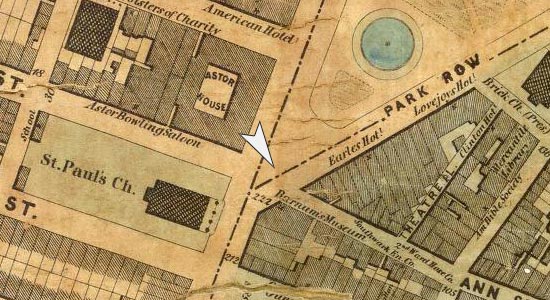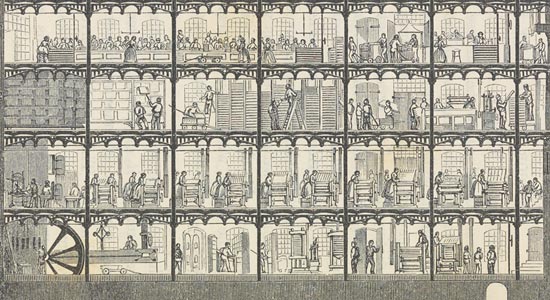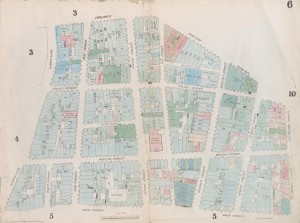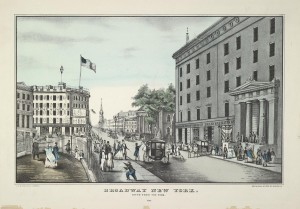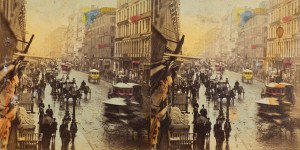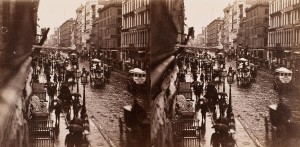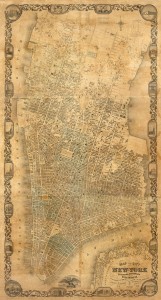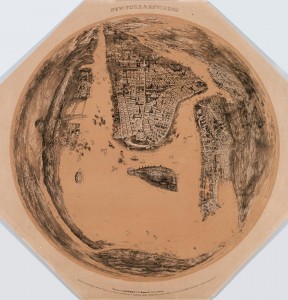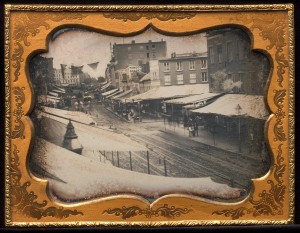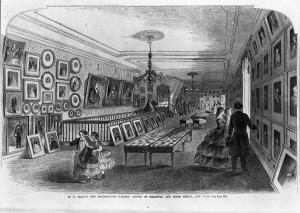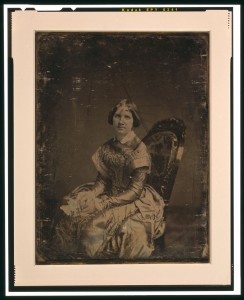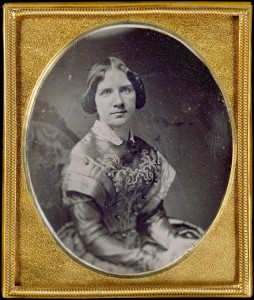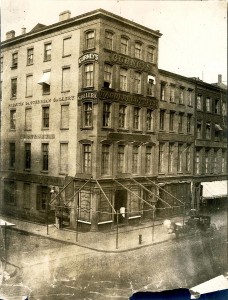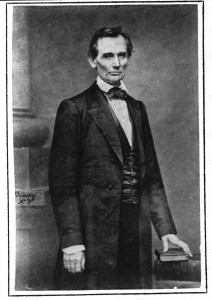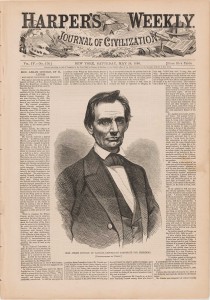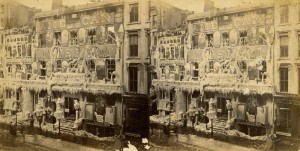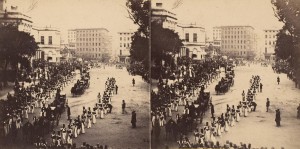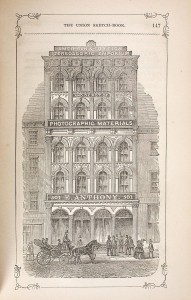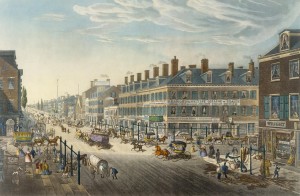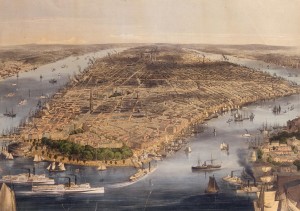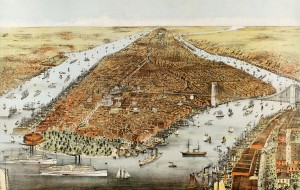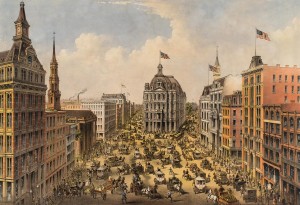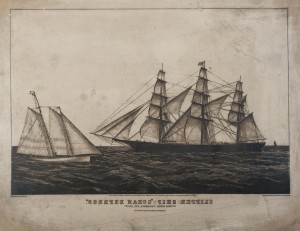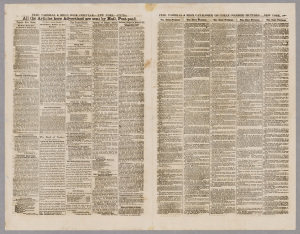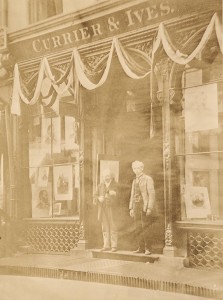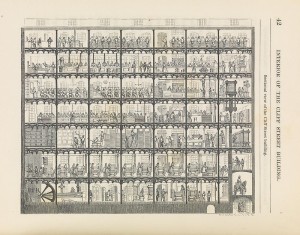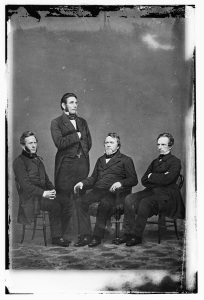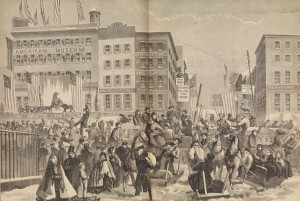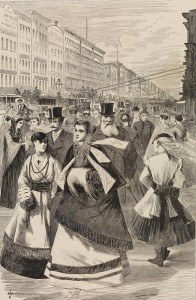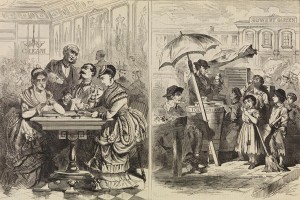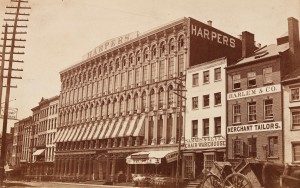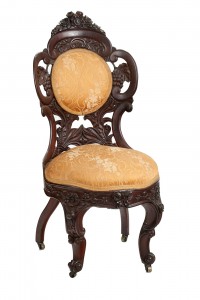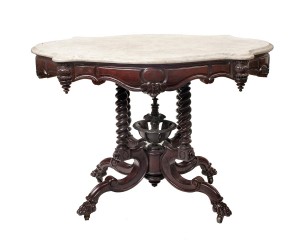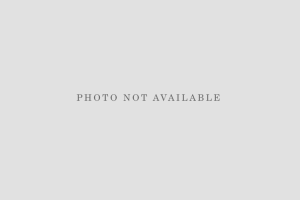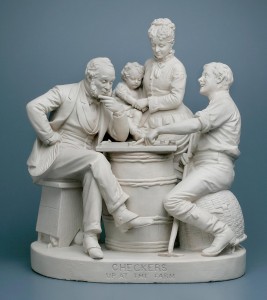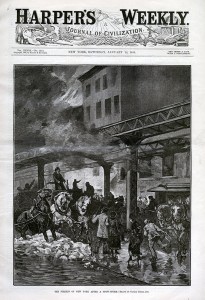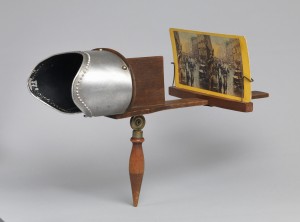Bibliography
Primary Sources - Books
Abbott, Jacob. The Harper Establishment; or, How the Story Books Are Made. New York: Harper & Brothers, 1855.
Barnum, P. T. The Life of P. T. Barnum Written by Himself. Introduction by Terence Whalen. Chicago: University of Illinois Press, 2007.
Berkeley, George. The Works of George Berkeley. Edited by Alexander Campbell Fraser. Volume 4. Oxford, UK: Clarendon Press, 1901.
Bobo, William. Glimpses of New York. Charleston: J. J. McCarter, 1852.
Browne, Junius Henri. The Great Metropolis, a Mirror of New York: A Complete History of New York. Hartford, CT: American Publishing Company, 1869.
Child, Lydia Maria. Letters from New-York. London: Richard Bentley, 1843.
Comettant, Oscar. Trois ans aux États-Unis: étude des moeurs et coutumes américaine. Paris: Pagnerre, 1857.
Dawson Burn, James. Three Years Among the Working-classes in the United States During the War. London: Smith, Elder and Co., 1865.
Dickens, Charles. American Notes for General Circulation. London: Chapman and Hall, 1842.
“Disastrous Fire, New York Times, July 14, 1865.” Center for History and New Media. Accessed November 26, 2012. http://chnm.gmu.edu/lostmuseum/lm/35/-
Documents of the Assembly of the State of New York, Issues 81-131. Albany, 1861.
Doesticks, Q.K. Philander (Mortimer Q. Thompson). What He Says. New York: Rudd & Carleton, 1857.
Downing, A. J. Rural Essays. New York: Leavitt & Allen, 1858.
Foster, George. New York in Slices. New York: W. F. Burgess, 1850.
Hall, Henry. American’s Successful Men of Affairs. An Encyclopedia of Contemporaneous Biography. Volume 1. New York: The New York Tribune, 1895.
Holmes, Oliver Wendell. Soundings from the Atlantic. Boston: Ticknor and Fields, 1864.
Kennion, John. The Architects’ and Builders’ Guide. New York: Fitzpatrick and Hunter, 1868.
Le Gray, Gustave. Traité Pratique de photographie sur papier et sur verre. Paris: Germer Ballière, 1850.
Makepeace Towle, George. American Society. 2 vols. London: Chapman and Hall, 1870.
Martin, Edward Winslow. The Secrets of the Great City. Philadelphia: National Publishing Company, 1868.
Mathews, Cornelius. A Pen-and-Ink Panorama of New-York City. New York: J. S. Taylor, 1853.
McCabe, James Henry. Light and Shadows of New York Life. New York: National Publishing Co., 1872.
Phelps’ Strangers and Citizens’ Guide to New York City: With Maps and Engravings. New York: Phelps and Watson, 1859.
Richards, William Carey. A day in the New York Crystal Palace and how to make the most of it: being a popular companion to the “Official catalogue”, and a guide to all the objects of special interest in the New York Exhibition of the Industry of All Nations. New York: G. P. Putnam, 1853.
Ryder, James F. Voigtlander and I: In Pursuit of Shadow Catching. Cleveland: The Cleveland Printing and Publishing Co., 1902.
Saunders, Frederick. New-York in a Nut-Shell, or Visitors’ Handbook to the City. New York: T. W. Strong, 1853.
Smith, Matthew Hale. Sunshine and Shadow in New York. New York: J. B. Burr, 1869.
Snelling, Henry Hunt, and Edward Anthony. A dictionary of the photographic art ... together with a list of articles of every description employed in its practice. New York: H.H. Snelling, 1854.
Walling, George Washington. Recollections of a New York Chief of Police. New York: Caxton Book Concern, 1887.
Werge, John. The Evolution of Photography: With a Chronological Record of Discoveries. London, Piper & Carter and J. Werge, 1890.
Whitman, Walt. Leaves of Grass: Facsimile of the 1856 Edition. Introduction by Gay Wilson Allen. Norwood, PA: Norwood Editions, 1976.
Williams, Edwin, John Disturnell, John Wiley, and Edwin B. Clayton. New-York as it is, in 1834. New York: J. Disturnell, 1834.
Primary Sources - Periodicals
American Journal of Science and Arts
Appletons’ Journal of Literature Science and Art
Arthur’s Home Magazine
The Atlantic
The Daguerreian Journal
The Decorator and Furnisher
Frank Leslie’s Illustrated Newspaper
Godey’s Lady’s Book
Harper’s New Monthly Magazine
Harper’s Weekly
Illustrated News
The Independent
International Art-Union Journal
Lady’s Almanac
The Nation
New York Evangelist
New York Evening Post
New York Herald
New York Mirror
New York Observer and Chronicle
New York State Mechanic
The New York Times
The North American Review
Photographic and Fine Art Journal
Putnam’s Monthly Magazine of American Literature, Science, and Art
Scientific American
The Youth’s Companion
Secondary Sources
Barth, Gunther. City People: The Rise of Modern City Culture in Nineteenth-Century America. Oxford: Oxford University Press, 1982.
Beckert, Sven. The Monied Metropolis: New York City and the Consolidation of the American Bourgeoisie, 1850–1896. Cambridge, UK: Cambridge University Press, 2003.
Bellion, Wendy. Citizen Spectator: Art, Illusion, and Visual Perception in Early National America. Chapel Hill: University of North Carolina Press, 2011.
Bender, Thomas. New York Intellect: A History of Intellectual Life in New York City from 1750 to the Beginnings of Our Own Time. New York: Alfred Knopf, 1987.
Benson, Susan Porter. Counter Cultures: Saleswomen, Managers, and Customers in American Department Stores, 1890–1940. Urbana: University of Illinois Press, 1986.
Bloomer, Carolyn M. Principles of Visual Perception. New York: Design Press, 1976.
Blumin, Stuart. “Explaining the New Metropolis: Perception, Deception, and Analysis in Mid-Nineteenth-Century New York City.” Journal of Urban History 11, no. 1 (November 1984): 9–38.
Brewer, John. “Sensibility and the Urban Panorama.” Huntington Library Quarterly 70, no. 2 (June 2007): 229–49.
Brown, Joshua. Beyond the Lines: Pictorial Reporting, Everyday Life, and the Crisis of Gilded Age America. Berkeley and Los Angeles: University of California Press, 2006.
Burrows, Edwin G., and Mike Wallace. Gotham: A History of New York City to 1898. Oxford: Oxford University Press, 2000.
Case, Nat. “John Bachman and the American Bird’s Eye View Print.” Imprint (Autumn 2008): 19–35.
Casper, Scott E., Jeffrey D. Groves, Stephen W. Nissenbaum, and Michael Winship, eds. A History of the Book in America. Volume 3: The Industrial Book, 1840–1880. Chapel Hill: American Antiquarian Society and University of North Carolina Press, 2007.
Cocks, Catherine. Doing the Town: The Rise of Urban Tourism in the United States, 1850–1915. Berkley and Los Angeles: University of California Press, 2001.
Cohen, Paul, and Robert Augustyn. Manhattan in Maps: 1527–1995. New York: Rizzoli, 1997.
Cook, James W. The Arts of Deception: Playing with Fraud in the Age of Barnum. Cambridge, MA: Harvard University Press, 2001.
Crary, Jonathan. Techniques of the Observer: On Vision and Modernity in the Nineteenth Century. Cambridge, MA: MIT Press, 1990.
Davis, Elliott Bostwick. missing information; chapter in Art and the Empire City?
Davis, Keith. The Origins of American Photography: From Daguerreotype to Dry-Plate, 1839–1885. New Haven: Yale University Press, 2007.
Deák, Gloria Gilda. Picturing America, 1497–1899: prints, maps, and drawings bearing on the New World discoveries and on the development of the territory that is now the United States. Princeton: Princeton University Press, 1988.
------. Picturing New York: The City from Its Beginnings to the Present. New York: Columbia University Press, 2000.
------. William James Bennett: Master of the Aquatint View. New York: New York Public Library, 1988.
Deming, M. Elen. “The Country and the City: John Bachmann’s Views of Manhattan and Central Park.” Landscape Journal 19, nos. 1/2 (2000): 111–25.
Earle, Edward W., ed. Points of View: The Stereograph in America—A Cultural History. Rochester, NY: Workshop Press, 1979.
Ernst, Robert. Immigrant Life in New York City: 1825–1863. Syracuse: Syracuse University Press, 1994.
Exman, Eugene. The Brothers Harper: A Unique Publishing Partnership and Its Impact on the Cultural Life of America from 1817 to 1853. Introduction by Allan Nevins. New York: Harper & Row, Publishers, 1965.
Foresta, Merry A., and John Wood. Secrets of the Dark Chamber: The Art of the American Daguerreotype. Washington, DC, and London: Smithsonian Institution Press, 1995.
Foster, George G. New York by Gaslight and Other Urban Sketches. Edited by Stuart M. Blumin. Berkeley and Los Angeles: University of California Press, 1990.
Fowles, Jib. “Stereography and the Standardization of Vision.” Journal of American Culture 17, no. 2 (June 1994): 89–93.
Gayle, Margot, and Carole Gayle. Cast-Iron Architecture in America: The Significance of James Bogardus. New York: W. W. Norton & Company, 1998.
Grier, Katherine C. Culture and Comfort: Parlor Making and Middle Class Identity, 1850–1910. Washington, DC, and London: Smithsonian Institution Press, 1997.
Griffiths, Anthony. Prints and Printmaking: An Introduction to the History and Techniques. Berkeley and Los Angeles: University of California Press, 1996.
Hales, Peter Bacon. Silver Cities: Photographing American Urbanization 1839–1939. Albuquerque: University of New Mexico Press, 2005.
Halttunen, Karen. Confidence Men and Painted Women: A Study of Middle-class Culture in America, 1830–1870. New Haven: Yale University Press: 1982.
Harley, J. B. “Deconstructing the Map,” Cartographica 26, no. 2 (Summer 1989): 1–20.
Harris, Neil. Humbug: The Art of P. T. Barnum. Boston: Little, Brown, 1973.
Henkin, David. City Reading: Written Words and Public Spaces in Antebellum New York. New York: Columbia University Press, 1999.
Hoskins, Lesley, ed. The Papered Wall: The History, Patterns and Techniques of Wallpaper. New York: Thames and Hudson: 2005.
Howe, Katherine S., Alice Cooney Frelinghuysen, and Catherine Hoover Voorsanger. Herter Brothers: Furniture and Interiors for a Gilded Age. New York: The Metropolitan Museum of Art, 1994.
Hyde, Ralph. “Thomas Hornor: Pictural Land Surveyor.” Imago Mundi: The International Journal for the History of Cartography 29, no. 1 (1977): 23–34.
Ingerman, Elizabeth A. “Personal Experiences of an Old New York Cabinetmaker.” Magazine Antiques 84, no. 5 (November 1963): 576–80.
Jackson, Kenneth T., and David S Dunbar. Empire City: New York through the Centuries. New York: Columbia University Press, 2002.
Jaffee, David. “Anthony’s Broadway on a Rainy Day: The Stereograph Comes to America.” Common-place.org 10.4 (July 2010): http://www.common-place.org/vol-10/no-04/lessons/
------. “Seeing in the City: Broadway and the Culture of Vision in 19th-Century New York” (unpublished manuscript).
Kasson, John F. Rudeness and Civility: Manners in Nineteenth-Century Urban America. New York: Hill and Wang, 1990.
Kouwenhoven, John Atlee. The Columbia Historical Portrait of New York: An Essay in Graphic History. Garden City, NY: Doubleday, 1953.
Krim, Arthur. “A Window on the Manhattan Metropolis: The Chatham Square Daguerreotype.” The Daguerreian Annual 1996 (1997): 23–35.
Kurlansky, Mark. The Big Oyster: History on the Half Shell. New York: Random House, 2007.
Laurie, Bruce. Artisans into Workers: Labor in Nineteenth-Century America. New York: Hill and Wang, 1989.
Laxton, Paul, ed. The New Nature of Maps: Essays in the History of Cartography. Baltimore: The John Hopkins University Press, 2001.
LeBeau, Bryan F. Currier & Ives: America Reimagined. Washington, DC, and London: Smithsonian Institution Press, 2001.
Lobel, Cindy. “Out to Eat: The Growth of New York City and its Restaurants.” Winterthur Portfolio 44, nos. 2/3 (Summer/Autumn 2010): 193–220.
Lynn, Catherine. Wallpaper in America from the Seventeenth Century to World War I. New York: Norton & Co., 1980.
Marder, William, and Estelle. Anthony: The Man, the Company, the Camera. Edited by Robert G. Duncan. Plantation, FL: Pine Ridge Publishing Co., 1982.
Marien, Mary Warner. Photography: A Cultural History. New York: Harry N. Abrams, 2002.
Masten, April. Art Work: Women Artists and Democracy in Mid-Nineteenth-Century New York. Philadelphia: University of Pennsylvania Press, 2008.
McCandless, Barbara. “The Portrait Studio and the Celebrity.” In Martha Sandweiss, ed., Photography in Nineteenth-Century America), 51–75. New York: Harry B. Abrams, 1991.
Mellby, Julie. “Victor Prevost: Painter, Lithographer, Photographer.” The History of Photography 35 (2011): 221–39.
Orcutt, Kimberly, ed. John Rogers: American Stories. New York: Philip Wilson Publishers, 2010.
Panzer, Mary. Mathew Brady and the Image of History. Washington. DC: Smithsonian Institution Press, 1997.
Peters, Harry T. Currier & Ives: Printmakers to the American People. 2 vols. Garden City, NY: Doubleday, Doran & Company, 1929–31.
Phelps Stokes, I. N. The Iconography of Manhattan Island, 1498–1909. 6 vols. New York: Robert H. Dodd, 1915–28.
Philadelphia: Three Centuries of American Art. Philadelphia: The Philadelphia Museum of Art, 1976.
Pirenne, M. H. Optics, Painting, and Photography. Cambridge: Cambridge University Press, 1970.
Reilly, Bernard F. Jr., ed. Currier & Ives: A Catalogue Raisonné. 2 vols. Detroit: Gale Research, 1984.
Reps, John. Views and Viewmakers of Urban America: Lithographs of Towns and Cities in the United States and Canada, Notes on the Artists and Publishers, and a Union Catalog of Their Work, 1825–1925. Columbia: University of Missouri, 1984.
Resseguie, Harry E. “A. T. Stewart's Marble Palace—The Cradle of the Department Store.” New-York Historical Society Quarterly 48 (1964): 131–62.
Richman, Jeffrey I., ed. Green-Wood at 175: Looking back/Looking forward. New York: The Green-Wood Cemetery, 2013.
Rock, Howard B., and Deborah Dash Moore. Cityscapes: A History of New York in Images. New York: Columbia University Press, 2001.
Robinson, Cervin, and Joel Herschman. Architecture Transformed. Cambridge, MA: MIT Press, 1987.
Sandoval-Strauss, Andrew K. Hotel: An American History. New Haven and London: Yale University Press, 2007.
Sandweiss, Martha A., ed. Photography in Nineteenth-Century America. Fort Worth, TX: Amon Carter Museum, and New York: Harry N. Abrams, 1991.
Schein, R.H. “Representing Urban America: 19th Century Views of Landscape, Space, and Power.” Environment and Planning D: Society and Space 11 (1993): 7–21.
Schwartz, Vanessa R., and Jeannene M. Przyblyski, ed. The Nineteenth-Century Visual Culture Reader. New York: Routledge, 2004.
Schulman, Vanessa Meikle. “Making the Magazine: Visuality, Managerial Capitalism, and the Mass Production of Periodicals, 1865–1890.” American Periodicals: A Journal of History, Criticism, and Bibliography 22, no. 1 (2012): 1–28.
Schultz, Stanley K. Constructing Urban Culture: American Cities and City Planning 1800–1920. Philadelphia: Temple University Press, 1989.
Schuyler, David. The New Urban Landscape: The Redefinition of City Form in Nineteenth-Century America. Baltimore: John Hopkins University Press, 1988.
Scobey, David M. “Anatomy of the Promenade: The Politics of Bourgeois Sociability in Nineteenth-Century New York.” Social History 17, no. 2 (May 1992): 203–27.
------. Empire City: The Making and Meaning of the New York City Landscape. Philadelphia: Temple University Press, 2002.
Sears, John F. Sacred Places: American Tourism in the Nineteenth Century. New York: Oxford University Press, 1989.
Seidler Ramirez, Jan, Michele Helene Bogart, and William R Taylor. Painting the Town: Cityscapes of New York. New Haven: Yale University Press, in association with the Museum of the City of New York, 2000.
Streifer Rubenstine, Charlotte. “The Early Career of Frances Flora Bond Palmer.” American Art Journal 17 (Autumn 1985): 71–88.
Tamilia, Robert D. “World’s Fairs and the Department Store 1800s to 1930s.” CHARM Proceedings 15 (2007): 228–40.
Thorn, John. Baseball in the Garden of Eden: The Secret History of the Early Game. New York: Simon & Schuster, 2012.
------, and Melanie Bower. New York 400. Philadelphia: Running Press, 2009.
Upton, Dell. Another City: Urban Life and Urban Spaces in the New American Republic. New Haven and London: Yale University Press, 2008
------, and John Michael Vlach. Common Places: Readings in American Vernacular Architecture. Athens: University of Georgia Press, 1986.
Voorsanger, Catherine Hoover, and John K. Howat, eds. Art and the Empire City: New York, 1825–1861. New Haven: Yale University Press and the Metropolitan Museum of Art, 2000.
Wainwright, Nicholas B. “Augustus Kollner, Artist.” The Pennsylvania Magazine of History and Biography 84, no. 3 (July 1960): 325–51.
Wilson, Robert. Mathew Brady: Portraits of a Nation. New York: Bloomsbury USA, 2013.
Wing, Paul. Stereoscopes: The First One Hundred Years. Nashua, NH: Transition Pub., 1996.
Wood, John, ed. The Daguerreotype: A Sesquicentennial Celebration. Iowa City: University of Iowa Press, 1989.

